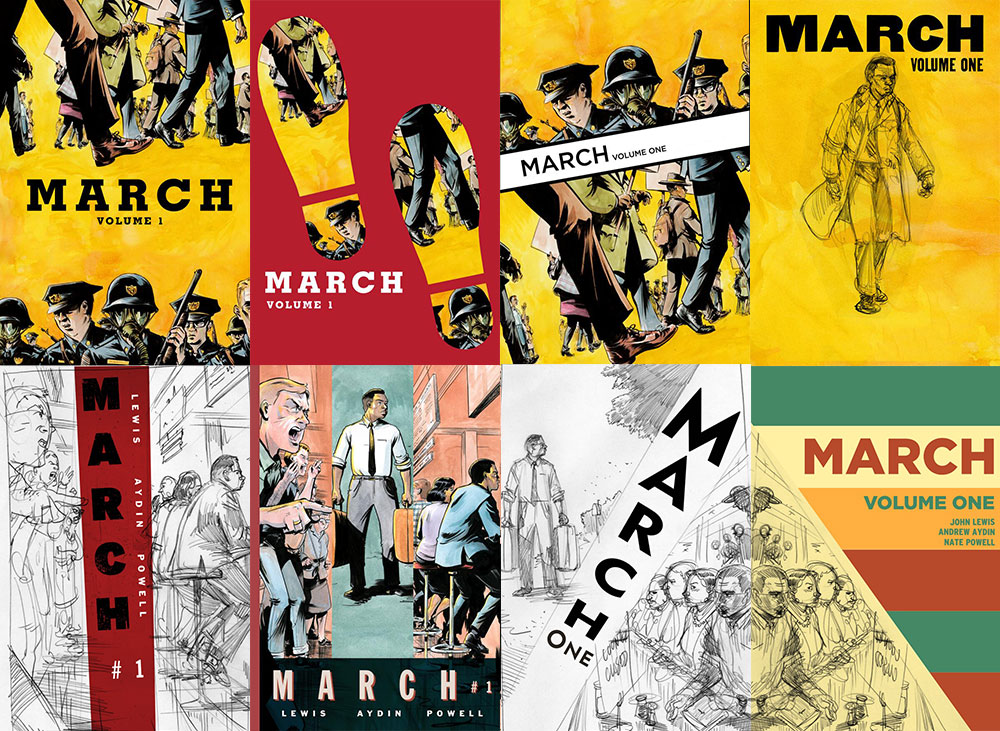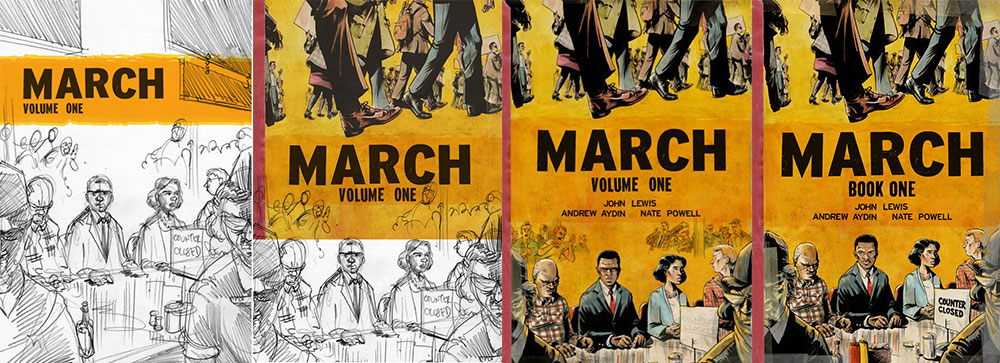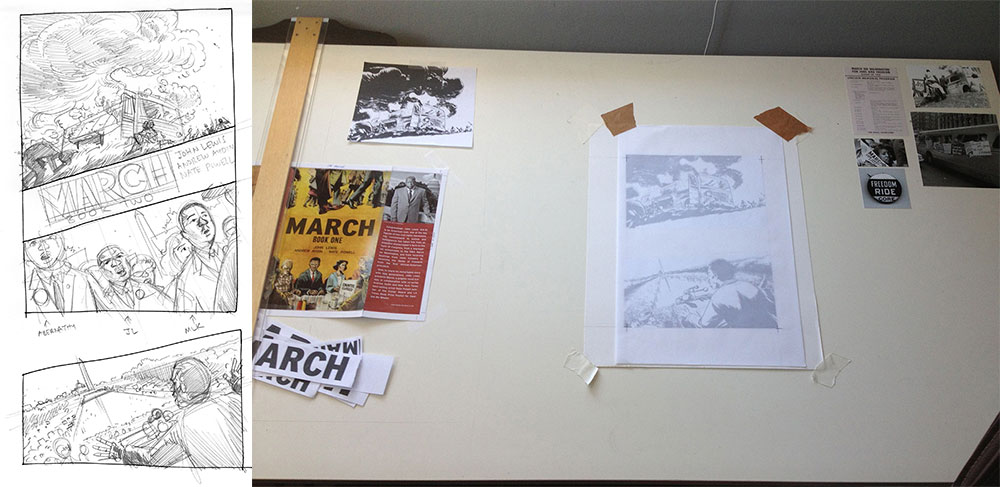Maybe the biggest highlight of a fairly eventful San Diego Comic Con was the moment when Congressman John Lewis cosplayed as himself, donning the trench coat and backpack he wore to march for voting rights across the Edmund Pettus Bridge in Selma, Alabama, 50 years ago. He led a touching children’s march through the halls of […]
Viewing: Blog Posts Tagged with: Andrew Aydin, Most Recent at Top [Help]
Results 1 - 4 of 4
Blog: PW -The Beat (Login to Add to MyJacketFlap)
JacketFlap tags: Conventions, Top Shelf, March, Top News, Nate Powell, Andrew Aydin, Rep John Lewis, Add a tag
Blog: PW -The Beat (Login to Add to MyJacketFlap)
JacketFlap tags: john lewis, Top News, Nate Powell, Chris Ross, Andrew Aydin, March: Book Two, design, History, Process, Top Shelf, Add a tag
by Nate Powell and Chris Ross
[Editor’s note: The release this week of March Book Two by Rep. John Lewis, Andrew Aydin and Nate Powell has already made headlines with its story of the fight for civil rights in the 60s, and the covers to both volumes have become iconic in their own right. The message of the courage to fight for equality for all in the face of violent opposition is as relevant and needed today as it was 50 years ago. But powerful images to cover powerful times don’t always spring up fully formed. Here Powell and Top Shelf designer Chris Ross with an in-depth breakdown of how they created these covers and combined imagery to capture both history and ideals.]
NATE: March was originally a single, massive volume, so the initial front and back covers were intended to house the entire narrative: the front introduced the basic visual theme of opposition, with two elements facing off against each other, though a contingent of riot-ready white supremacist police were prominently featured across the bottom. After some discussion with Chris Ross, Andrew Aydin, and Congressman Lewis, we all agreed that we should shift some of that focus to the folks on the front lines, and away from Jim Crow police forces. Around that time, we decided to release the saga as a trilogy, so Chris and I jumped in to further develop the oppositional themes, but playing with different angles and approaches to the cover’s division.

NATE: The marching feet motif, like the book’s title, are rooted in one of Congressman Lewis’ favorite Martin Luther King quotes, “There is no sound more powerful than the marching feet of a determined people.” We experimented with a lot of other design elements, but in the end kept coming back to that unshakable image.
CHRIS: I think we also had to be very conscious of being white males metaphorically designing the “skin” of a graphic novel about the civil rights movement. For example, there’s a common trope in graphic design, especially featuring marginalized people, of representing characters as body parts, “cut off” by the edges and removed from any context. Women are reduced to legs, breasts, or butts. Black men are reduced to chests and backs. Lots of folks believe that that’s not coincidental, and doing that carries a unique meaning when we represent the race and the body. So in the context of marching feet, it’s important to add depth and see whole bodies in the background, while also showing faces where we can, conveying an accurate and diverse range of these folks’ unique experiences and emotional states. It gives context to the movement and The Movement.
 NATE: Once we settled on the lunch counter setting and I’d rendered it, a few more essential steps unfolded; importantly, there were a few re-draws of young John Lewis’ face to more perfectly capture his likeness, but several compositional changes occurred (eliminating the crowd of white heckers in the background, making the “Counter Closed” sign more legible, and adding condiment bottles to the counter, which really tied the whole room together, as The Dude might put it).
NATE: Once we settled on the lunch counter setting and I’d rendered it, a few more essential steps unfolded; importantly, there were a few re-draws of young John Lewis’ face to more perfectly capture his likeness, but several compositional changes occurred (eliminating the crowd of white heckers in the background, making the “Counter Closed” sign more legible, and adding condiment bottles to the counter, which really tied the whole room together, as The Dude might put it).
CHRIS: The type treatment began as Nate’s hand-rendered type, but the book “read” as a Nate Powell Book (alongside the fantastic Any Empire and Swallow Me Whole). This isn’t a problem because a Nate Powell Book is important and beautiful (as is Nate Powell), but March is in a different category and should have its own identity. So, we made a type treatment that was drawn from the interstate highway system, alongside some key fonts that I completely ripped off serve as homage to Eric Skillman [designer of Alec: The Years Have Pants and the Criterion Collection], whose spirit I tried to summon. Skillman is such a talented designer. So then I played with the type until it looked like the logotype March has always existed.
NATE: Chris had an incredible vision of the books as objects, as documents of that era whose contents had also survived the struggle. He brilliantly envisioned Book One as a second-hand textbook one might find in a segregated rural African-American school, like the one young John Lewis attended; the volume would bear the marks of excessive taping and binding, spine and corner wear… and the signed-and-numbered hardcover itself would include mid-century library card inserts and stamps.
CHRIS: Thanks Tualatin Elementary School librarians! But that is sort of an emerging trope—books as objects from other time periods and existing as living objects. I think it works when the designer and artist and author consider that the cover is not only going to communicate something to the reader, but that it will live a life exclusively with the reader. That’s a nice way of saying patina works in interesting ways and meanings on a cover, but it really does detract, in my opinion, when it’s an interior design choice. It makes me wonder how these books with interior patinas will affect readability in ten–twenty years. I’m guilty of thinking and designing like that myself. I think it seems like an easy tool in the toolchest, and I have to remember these books will last (and should be built to last) a long time. They live, as any teacher or librarian will tell you.
NATE: Likewise, Book Two’s cover is a survivor of that fateful bus burning along the Freedom Ride in Alabama, bearing the scorch marks and reconstructive tape necessary to keep it together as the Movement itself was threatened to be derailed.
CHRIS: The tape was originally the tape I was going to use on The Underwater Welder cover, but decided to go with a fabric texture with Welder and remembered the tape when we were noodling on March.
 NATE: We knew almost immediately what I wanted to be represented on the cover of Book Two, so it came together with very minimal sketching, but also opened up a series of conversations among the creative team. Congressman Lewis wanted to make sure that, even as a young man amidst the center of the Freedom Ride, he wasn’t exploiting the power of that burning bus’s image for the cover. Rep. Lewis had actually left the Freedom Ride for a couple of days to interview for activist work abroad, and as he was about to rejoin the Riders he discovered his bus had been attacked.
NATE: We knew almost immediately what I wanted to be represented on the cover of Book Two, so it came together with very minimal sketching, but also opened up a series of conversations among the creative team. Congressman Lewis wanted to make sure that, even as a young man amidst the center of the Freedom Ride, he wasn’t exploiting the power of that burning bus’s image for the cover. Rep. Lewis had actually left the Freedom Ride for a couple of days to interview for activist work abroad, and as he was about to rejoin the Riders he discovered his bus had been attacked.
CHRIS: It’s such a dramatic rendering.
NATE: It was a powerful moment for reflection: that these experiences and their suffering were, part of a collective journey for liberation, but that can never undermine the fact that they were specific, real acts of terrorism inflicting deep trauma, injury, and death. To young John Lewis’ friends, neighbors, heroes, and to himself. It was a call to be mindful of ownership over these experiences. At the same time, he (and we) measured his own mandate to “tell the whole story,” to “make it plain.” At our consensus, I drew an alternate top for the Book Two cover depicting demonstrators at the March On Washington moving across the National Mall. After careful consideration, Congressman Lewis concluded that the original cover spoke more powerfully to the whole truth of the Movement and its struggle.
CHRIS: That alternative cover is really interesting, and it plays against the angles that we had set up, the angles of action. If we were going that way, we’d have to reconsider the dutch angle and the directions of movement above and below the title.
 NATE: Color and angles have played an important role in reflecting both the books’ individual contents and their placement in the narrative arc: Book One is largely the yellow of caution and instruction, urging slow, careful movements before the saga intensifies. Book Two is mostly the blue-and-grey of the previous century’s American Civil War, but carrying the gold/green/red palette of the first book forward as well. I will only briefly mention that the cover of Book Three may use the color scheme of the Alabama state flag, and the previously separated opposing elements have now been pushed into the same picture plane. The volumes begin with flat, ninety-degree compositions, but shift in design and camera placement as the Movement intensifies, echoing a literal escalation of angles across the covers.
NATE: Color and angles have played an important role in reflecting both the books’ individual contents and their placement in the narrative arc: Book One is largely the yellow of caution and instruction, urging slow, careful movements before the saga intensifies. Book Two is mostly the blue-and-grey of the previous century’s American Civil War, but carrying the gold/green/red palette of the first book forward as well. I will only briefly mention that the cover of Book Three may use the color scheme of the Alabama state flag, and the previously separated opposing elements have now been pushed into the same picture plane. The volumes begin with flat, ninety-degree compositions, but shift in design and camera placement as the Movement intensifies, echoing a literal escalation of angles across the covers.
CHRIS: I remember one of the color guides we were thinking about was really blue and yellow (the second from the left above), like Boy Scout blue and yellow, and it made the cover vibrate, but not really in a way that was communicating what we wanted to communicate. 
NATE: Just as we aimed for consistency and progression of theme on the front covers and total package, Chris Ross presented the idea of creating a triptych out of the saga’s back covers. One of us brought up the idea of Theodore Parker’s quote, adapted and immortalized by Dr. King, that the “arc of the moral universe is long, but it bends toward justice”, and we didn’t have to look long to find a perfect physical arc in the Edmund Pettus Bridge itself.
CHRIS: I wanted that as an art piece—a consistent narrative arc through time and this project. Standalone. Thematically linked through history that these conflicts get played out over longer time periods than humans live, and that through hard work and sacrifice, it gets incrementally better…we hope.
NATE: As I remember, I drew the Book One back cover waaaaay back in late 2011, when March was a single volume. I could see it very clearly in my mind’s eye, and just did one quick watercolor sketch before turning in the finished piece. Once we decided to make it a trilogy the next summer, we started looking ahead in content to pull out physical arcs and arches that might apply to our concept. I knew that Book Two would end with the bombing of 16th Street Baptist in Birmingham and wanted the blown-out window to be on the back cover as an eternal echo of the book itself, but it wasn’t until I started gathering more reference, much closer to the book’s end, that I realized the arch already continued in the blown-out window’s design.
 CHRIS: We also chose to crop the image on the back so that it displayed four missing panels—representing the four girls killed in the bombing. Then those missing panels become rays of sunshine.
CHRIS: We also chose to crop the image on the back so that it displayed four missing panels—representing the four girls killed in the bombing. Then those missing panels become rays of sunshine.
 CHRIS: We find these coincidental things in our “discovery” of a cover, and it’s like they’re always already there. It’s also why I like designing covers FAR in advance of their release: not just for marketing reasons, but so that the creators can live with it for a long time, to become intimate with the cover, to feel like that cover has always existed. In fact, the book cover for March: Book Two was finished a few days after we finished the cover for Book One. Right now, we’re narrowing down the cover for Book Three.
CHRIS: We find these coincidental things in our “discovery” of a cover, and it’s like they’re always already there. It’s also why I like designing covers FAR in advance of their release: not just for marketing reasons, but so that the creators can live with it for a long time, to become intimate with the cover, to feel like that cover has always existed. In fact, the book cover for March: Book Two was finished a few days after we finished the cover for Book One. Right now, we’re narrowing down the cover for Book Three.
NATE: On that note, I remembered the Birmingham window from my initial reading of Walking with the Wind, its Christ’s face blown out by the explosion—but I had to check in with Andrew and the Congressman halfway through drawing Book Two, in which the face of Christ is also blown out by a brick at First Baptist in Montgomery in 1961. It was eerie and disturbing to confirm both of these events, and from a writing perspective, the kind of thing you just can’t make up. So there it was. There they both were.
CHRIS: I didn’t know that—and that both these representations become something a bit more profound, a bit more representative of the movement. Kindness in the face (literally) of violent oppression.
NATE: We have elements in place to continue the overarching composition for Book Three—that’s being worked on right now (it’s sitting next to me at the desk!), but nothing to show yet. Back to the drawing table… gotta get these color sketches for the next cover done pronto!
CHRIS: That’s really the fun, terrifying, crazy, beautiful part: finding the engine of meaning and narrative in this story and doing some very Deep Thinking about what this engine looks like, how the elements that aesthetically speak to you play with Rep. Lewis’, Andrew’s, and Nate’s story. And represent them in meaningful ways. And hope that they always appear to have always existed.
March: Book One and March: Book Two are in stores now from Top Shelf Productions, an imprint of IDW Publishing.
Blog: PW -The Beat (Login to Add to MyJacketFlap)
JacketFlap tags: Top Shelf, Dragon*Con, Top News, Nate Powell, Andrew Aydin, Rep John Lewis, Add a tag
By Hannah Lodge
A little more than 51 years ago, Rep. John Lewis was one of ten people to speak at the March on Washington, where Dr. Martin Luther King, Jr. made his historic “I Have a Dream” speech. Of those ten, Lewis is the only one still alive today.
1 of 10.
Lewis’s life is filled with meaningful numbers: 74 – his age; 5 – his congressional district; 37 – the number of days he spent in jail for using a “white-only” restroom; 45 – the number of times he’s been arrested.
Lewis and Legislative Aide Andrew Aydin appeared on a panel at Dragon Con in Lewis’s home district of Atlanta for their co-authored graphic novel, March: Book One, where they dropped another meaningful number: 47 – the number of states failing to adequately teach the Civil Rights Movement.
At the intersection of historical and modern is March: Book One, a timeless message delivered in a progressive medium. Aydin, who has attended Dragon Con for years and has always loved comics, said he saw an opportunity to use a graphic novel to educate on the Civil Rights Movement when Persepolis, a graphic novel published in 2000 detailing the war between Iran and Iraq, began to appear on school curricula.
“There is an opening we have now, where graphic novels are being accepted as literature, and I think someone like Congressman Lewis embarking on this journey into the medium only bolsters that credibility,” Aydin said. “In fact, he’s the first member of Congress to write a graphic novel.”
Aydin said March was designed with an inexpensive price point so that it would be feasible for school budgets. The graphic novel has been selected as a common reading book – a book read by the incoming freshman class over the summer for interactive discussions in their first year – at Michigan State University, Marquette University and Georgia State University. MSU and the City of East Lansing also sponsor a “One Book, One Community Program” in which members of the community and the freshman class participate in the reading and discussion together.
Amid national outcry over recent events in Ferguson, the book’s messages are as timely now as ever. Lewis spoke at the panel about the day that would eventually be known as “Bloody Sunday,” when 600 nonviolent protesters marched in a demonstration for the right to vote.
“I was the first to be attacked,” he said. “I was hit in the head by a state trooper with a night stick. I had a concussion on the bridge. I thought I saw death. I thought I was going to die.”
The brutality made it to the news, which caused a ripple effect of demonstrations in more than 82 cities across America. Only eight days later, President Lyndon B. Johnson would make a speech now known as the “We Shall Overcome” speech, which Lewis called “one of the most meaningful speeches that any American president had made in modern times on the oppression of civil rights and voting rights.”
Lewis said that the series of events sparked by the demonstration eventually led to change.
“I was sitting next to Dr. King in the home of a local family, as we watched and listened to President Johnson, and tears came down his face. He started crying, and we all cried,” he said. “Dr. King said: ‘We’ll make it from Selma to Montgomery, and the voting right will be passed.’ Congress debated it, passed it, and it was signed into law. Some people gave their lives, and the only thing I gave was a little blood.”
Aydin said March goes into great detail about the communication methods used to set up demonstrations, which are the most effective tool for creating change. Aydin said he thinks social networking tools like Twitter can be used to motivate and organize demonstrations, but shouldn’t take the place of them.
“An incident happens in one city, and having the infrastructure to have those protests follow up in a nationwide way is what helps put national pressure on the elected leaders,” he said. “You’ve got to show up. That’s the biggest battle. All these people, if they’re mad, if they’re angry, if there’s something they believe in, they need to be there. They need to make their voice heard through their own presence. You’ve got to use your bodies. Put your bodies on the line to make your voice heard.”
Lewis echoed that sentiment, adding that he thinks we’ve reached a time in our history where our voices are not being used enough.
“The day will come I think, in the not so distant future, when people will look back and say ‘Why were we so quiet?’” he said. “There comes a time when people should make a little noise and push.”
Aydin said he is hopeful that through the book and their discussions at schools, they will help encourage a new generation of activists.
“We’re going to these schools all across the country, as many as we can possibly go to, so that we find that one kid. That one young person who starts the ball rolling, who has that first moment of courage,” he said.
And just as progress was made for civil rights, Lewis said he believes it’s important that people continue to organize to battle other issues; particularly the fight for economic equality.
“The last effort of Martin Luther King, Jr. was something called The Poor People’s campaign,” he said. “He wanted to take people to Washington, representatives of people who’d been left out and left behind. They were white, black, Latino, Asian America, Native American – and he never made it there because of the assassination in Memphis. I think in a real sense we have to pick up where Dr. King left off… It doesn’t make sense that a few people can earn so much and then hundreds of thousands of people in our country don’t know where they’re going to get their next meal or where they’re going to sleep. It’s not fair, it’s not right, and it’s not just.”
Blog: PW -The Beat (Login to Add to MyJacketFlap)
JacketFlap tags: Top Shelf, john lewis, Top News, Andrew Aydin, March: Book Two, Nate Powell, Add a tag
March: Book One, the graphic novel memoir of civil rights hero Rep. John Lewis, as adapted by Andrew Aydin and Nate Powell, was a bestseller and gained publicity previously little heard of for a graphic novel, with appearances on the Colbert Report and Rachel Maddow among many other places. The first volume has been a best seller but also inspired readers with its story of Lewis’s youthful initiation into the civil rights movement. The book is currently in the freshman reading programs at three universities, and has been nominated for three Eisner Awards.

But there’s a lot more to the story. The cover for March: Book Two, which will be out in early 2015, has finally been revealed, on CNN of all places. And Top Shelf has announced Book Two will be an even longer book, as it builds towards the defining events of 1961-1963. Book Two covers:
the famous journey of the Freedom Riders, imprisonment at Mississippi’s Parchman Penitentiary, and young John Lewis’ involvement in helping to plan and lead the legendary 1963 March on Washington.
Nate Powell’s powerful cover showcases (on top) the Freedom Riders’ bus set on fire by a white supremacist mob in Anniston, AL, May 14, 1961, and (on bottom) Lewis’ fiery speech at the March on Washington, August 28, 1963
March: Book Two will be available the regular softcover edition and two special editions, which can both be pre-ordered: a hardcover editionand a limited edition signed & numbered hardcover.








Yeah, giving them the vote, look how well that turned out. Any wonder the country’s in the mess it is.